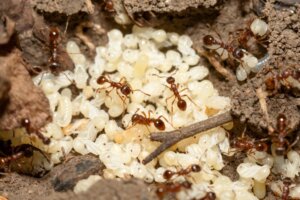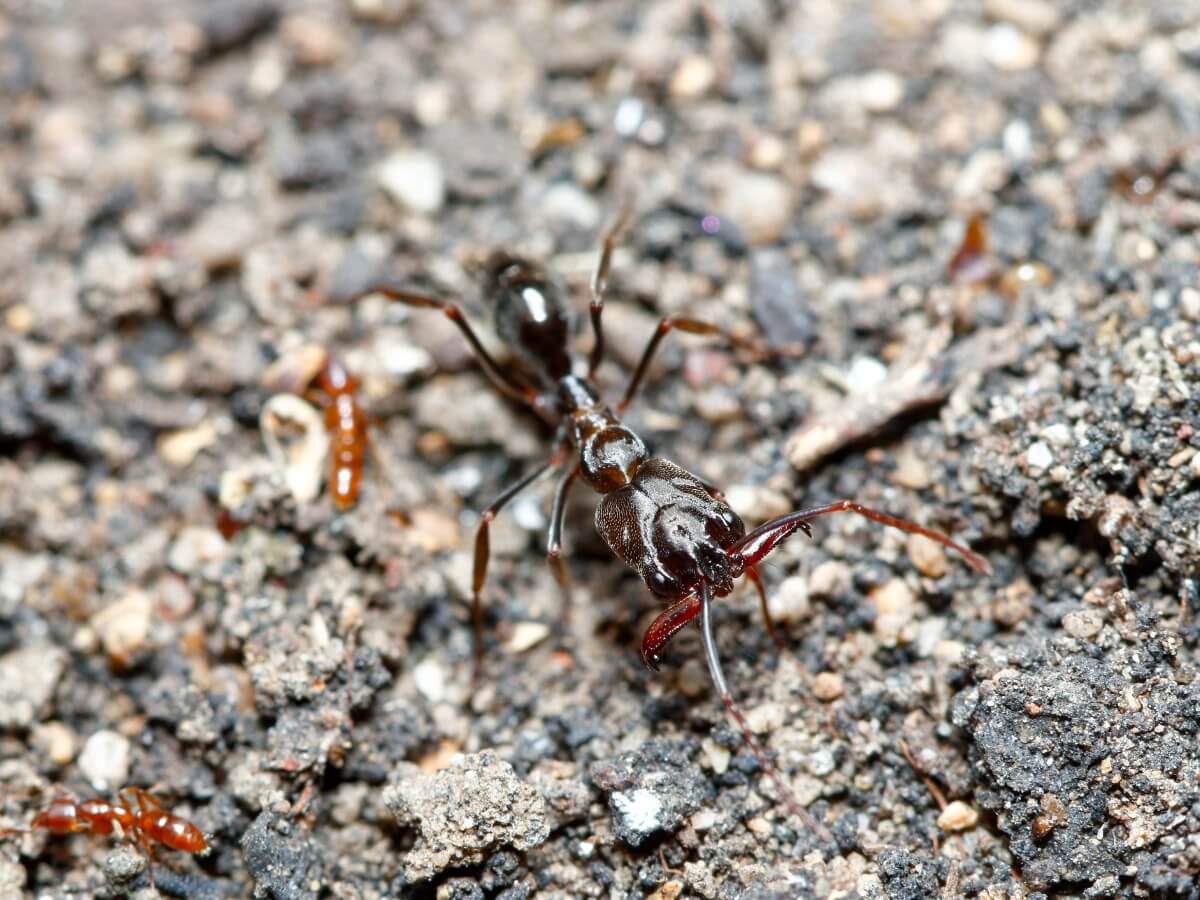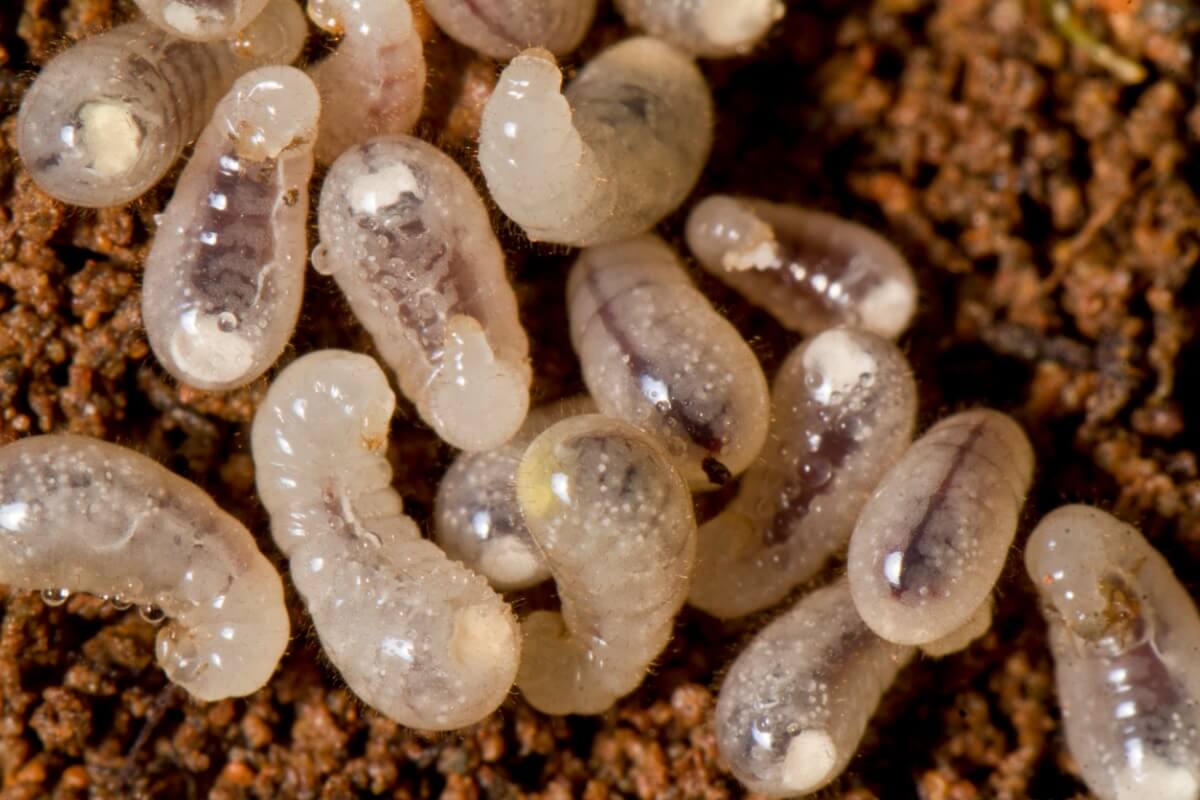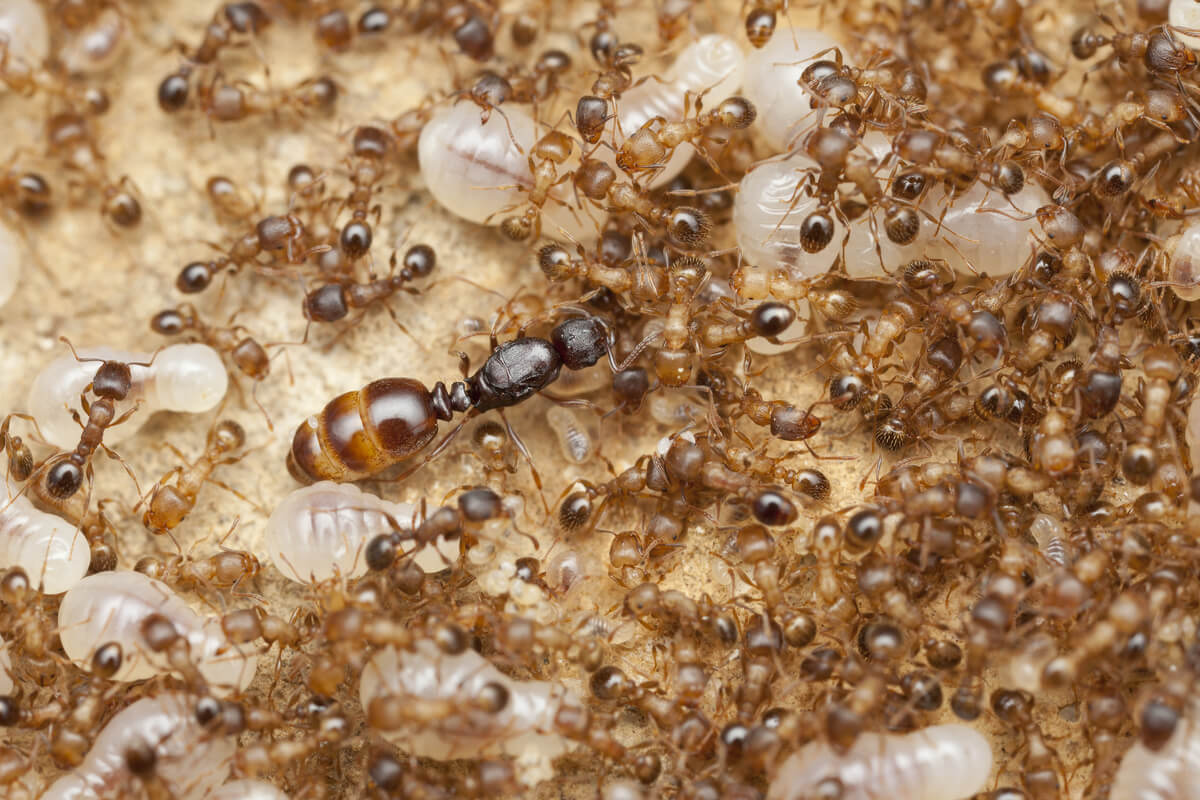How Ants Are Born!


Written and verified by the biologist Georgelin Espinoza Medina
Ants are common insects all over the world. They’re defined as hard-working, strong, bold and are usually observed in groups. They have extraordinary organization that helps them to survive, since their success is based on the division of tasks. It’s very likely that, at some point, you’ll have come across one of them, but do you know how ants are born?
There are more than 10,000 species of ants or Formicidae (family Formicidae), which are, in turn, included in the order Hymenoptera (like bees and wasps). All of them go through different stages from birth until they become adults. Read on to find out how ants are born, how they reproduce, and their life cycle.
What are ants like?
Ants are small insects (usually no larger than 2 centimeters) with bodies divided into 3 sections: a large head with a pair of angled antennae and strong mandibles, a thorax with 3 pairs of legs and an abdomen that may have a defensive stinger in some species. There are also some ants with membranous wings present on the thorax.
Their coloration is dark and they’re most commonly black or brown, but there are also ants in red, greenish, or yellow tones. They have a wide distribution and are found almost everywhere in the world, with the exception of Antarctica.
These insects occupy diverse environments and live together as an organized society. They manage to survive thanks to their teamwork.

Social organization
One of the important aspects when it comes to understanding how ants are born is their organization, as it isn’t at all simple. There are different types of ants or castes within the same society, each one with an established function. They’re the following:
- Queens: There may be one or several queens per colony and they’re the most hierarchical and largest, and are in charge of laying the eggs. They’re ants with wings in their first stages, but the wings fall off when they’re established in the nest. They can live 10 years or more.
- Workers: They’re females that don’t have wings and are the most numerous and smallest. They fulfill different roles within the anthill (defense, feeding, and construction, among others). They live for a short time and each colony has hundreds or thousands of specimens.
- Males: They have wings and are responsible for mating with the queen so that the new offspring can be engendered. They live just a few days.
How do ants reproduce?
The reproduction of ants is quite peculiar, since the fertilization of the egg (or lack thereof) will determine the sex of the insect. When queen and male mate, fertilized eggs give rise to females, while unfertilized eggs give rise to males.
In this way, females have a complete genetic load (because they come from the union of mother and father, queen and male). On the other hand, males have half the chromosomes (which come only from the queen mother).
As it has been stated, ants are oviparous and their reproduction occurs in the air, which is known as nuptial flight. Males guide females towards them by chemical mechanisms or vice versa (by pheromones). After mating, the queens look for an appropriate place to lay their eggs, which is usually underground.
How are ants born?
These insects go through several stages or phases to complete their life cycle (egg, larva, pupa, and adult). After the laying of the ant eggs (and when the gestation is complete) comes the hatching of the new members of the colony, but these arrive in the form of larvae.
The newborn ants have a worm-like appearance, usually light-colored and small. A head and several body segments can be distinguished on their body. Newborn ants are soft, but then they acquire hardness during growth and metamorphosis.
As an example, we have the species Solenopsis picea, or predatory ant. Studies showed that the newly hatched larvae are soft, with a cephalic capsule or head between 0.1 and 0.3 millimeters, while registering a total length of 0.1 to 1.44 centimeters. Although the size of the larva seems small, this proportion is sufficient for the development of the ant.
After the larva stage follows the pupa stage, in which some specimens are wrapped in cocoons to undergo metamorphosis and develop as the typical adult. The total duration of the life cycle is variable in different species. For example, in the predatory ant it ranges from 23 to 50 days, but longer periods have been observed.
Some species don’t pupate, so the metamorphosis from larva to adult can be observed with the naked eye.

Birth of workers
As we have seen, workers correspond to females. They’re produced by fertilization of the male with the reproductive ant, the queen. This one has in her body a kind of sac (spermatheca) in which she keeps the sperm of this mating and she uses it during her whole life to fertilize the eggs, except those of the males.
After the nuptial flight, the queen looks for an optimal place. When she gets it, she loses her wings and takes over her main task: laying eggs. She’ll try to take care of them and protect them while they develop in the founding stage of the colony.
From these eggs, the first worker ants hatch, initially in the form of larvae (with the same appearance as described). Then they go through the pupa stage and finally become adults ready to take care of the queen, the other eggs, feed the larvae, and defend the colony. The first workers in the anthill are known as nurses.
How are queen ants born?
Like the workers, queens come from the fertilized eggs of the queen and the male. They emerge as larvae with the same characteristics, but are larger and receive a different diet, more suitable for their growth as the future basis of a colony. This occurs from time to time, when conditions are favorable and the nest is well established.
Generally, unfertilized queens (princesses) develop wings that allow them to disperse and colonize other places, fulfilling the cycle that we have mentioned. Larger queens have more opportunities to form independent colonies than smaller ones.
The queens have fat reserves that allow them to survive while the workers develop.
In some species, wingless queens can be developed, which develop their colonies without dispersing more territory in the vicinity of the mother’s nest. There are even parasitic queens that invade colonies. These manage to kill or expel the resident, but they can also host workers and other queens to work in their favor.
How are male ants born?
To generate male ants, no sperm is needed, since they come from unfertilized eggs. Like the rest of the ant castes, the larva emerges from the egg, then pupates and finally becomes a winged adult, ready to reproduce. Generally, their life is short and the male perishes after mating.

Explaining how ants are born is complex. Although they possess a fascinating organization that allows them great success in the world, they’re fragile and care-dependent insects when they’re newly emerged from the egg. Moreover, the larvae are unrecognizable at first glance and look very different from the adults. Incredible, isn’t it?
Ants are common insects all over the world. They’re defined as hard-working, strong, bold and are usually observed in groups. They have extraordinary organization that helps them to survive, since their success is based on the division of tasks. It’s very likely that, at some point, you’ll have come across one of them, but do you know how ants are born?
There are more than 10,000 species of ants or Formicidae (family Formicidae), which are, in turn, included in the order Hymenoptera (like bees and wasps). All of them go through different stages from birth until they become adults. Read on to find out how ants are born, how they reproduce, and their life cycle.
What are ants like?
Ants are small insects (usually no larger than 2 centimeters) with bodies divided into 3 sections: a large head with a pair of angled antennae and strong mandibles, a thorax with 3 pairs of legs and an abdomen that may have a defensive stinger in some species. There are also some ants with membranous wings present on the thorax.
Their coloration is dark and they’re most commonly black or brown, but there are also ants in red, greenish, or yellow tones. They have a wide distribution and are found almost everywhere in the world, with the exception of Antarctica.
These insects occupy diverse environments and live together as an organized society. They manage to survive thanks to their teamwork.

Social organization
One of the important aspects when it comes to understanding how ants are born is their organization, as it isn’t at all simple. There are different types of ants or castes within the same society, each one with an established function. They’re the following:
- Queens: There may be one or several queens per colony and they’re the most hierarchical and largest, and are in charge of laying the eggs. They’re ants with wings in their first stages, but the wings fall off when they’re established in the nest. They can live 10 years or more.
- Workers: They’re females that don’t have wings and are the most numerous and smallest. They fulfill different roles within the anthill (defense, feeding, and construction, among others). They live for a short time and each colony has hundreds or thousands of specimens.
- Males: They have wings and are responsible for mating with the queen so that the new offspring can be engendered. They live just a few days.
How do ants reproduce?
The reproduction of ants is quite peculiar, since the fertilization of the egg (or lack thereof) will determine the sex of the insect. When queen and male mate, fertilized eggs give rise to females, while unfertilized eggs give rise to males.
In this way, females have a complete genetic load (because they come from the union of mother and father, queen and male). On the other hand, males have half the chromosomes (which come only from the queen mother).
As it has been stated, ants are oviparous and their reproduction occurs in the air, which is known as nuptial flight. Males guide females towards them by chemical mechanisms or vice versa (by pheromones). After mating, the queens look for an appropriate place to lay their eggs, which is usually underground.
How are ants born?
These insects go through several stages or phases to complete their life cycle (egg, larva, pupa, and adult). After the laying of the ant eggs (and when the gestation is complete) comes the hatching of the new members of the colony, but these arrive in the form of larvae.
The newborn ants have a worm-like appearance, usually light-colored and small. A head and several body segments can be distinguished on their body. Newborn ants are soft, but then they acquire hardness during growth and metamorphosis.
As an example, we have the species Solenopsis picea, or predatory ant. Studies showed that the newly hatched larvae are soft, with a cephalic capsule or head between 0.1 and 0.3 millimeters, while registering a total length of 0.1 to 1.44 centimeters. Although the size of the larva seems small, this proportion is sufficient for the development of the ant.
After the larva stage follows the pupa stage, in which some specimens are wrapped in cocoons to undergo metamorphosis and develop as the typical adult. The total duration of the life cycle is variable in different species. For example, in the predatory ant it ranges from 23 to 50 days, but longer periods have been observed.
Some species don’t pupate, so the metamorphosis from larva to adult can be observed with the naked eye.

Birth of workers
As we have seen, workers correspond to females. They’re produced by fertilization of the male with the reproductive ant, the queen. This one has in her body a kind of sac (spermatheca) in which she keeps the sperm of this mating and she uses it during her whole life to fertilize the eggs, except those of the males.
After the nuptial flight, the queen looks for an optimal place. When she gets it, she loses her wings and takes over her main task: laying eggs. She’ll try to take care of them and protect them while they develop in the founding stage of the colony.
From these eggs, the first worker ants hatch, initially in the form of larvae (with the same appearance as described). Then they go through the pupa stage and finally become adults ready to take care of the queen, the other eggs, feed the larvae, and defend the colony. The first workers in the anthill are known as nurses.
How are queen ants born?
Like the workers, queens come from the fertilized eggs of the queen and the male. They emerge as larvae with the same characteristics, but are larger and receive a different diet, more suitable for their growth as the future basis of a colony. This occurs from time to time, when conditions are favorable and the nest is well established.
Generally, unfertilized queens (princesses) develop wings that allow them to disperse and colonize other places, fulfilling the cycle that we have mentioned. Larger queens have more opportunities to form independent colonies than smaller ones.
The queens have fat reserves that allow them to survive while the workers develop.
In some species, wingless queens can be developed, which develop their colonies without dispersing more territory in the vicinity of the mother’s nest. There are even parasitic queens that invade colonies. These manage to kill or expel the resident, but they can also host workers and other queens to work in their favor.
How are male ants born?
To generate male ants, no sperm is needed, since they come from unfertilized eggs. Like the rest of the ant castes, the larva emerges from the egg, then pupates and finally becomes a winged adult, ready to reproduce. Generally, their life is short and the male perishes after mating.

Explaining how ants are born is complex. Although they possess a fascinating organization that allows them great success in the world, they’re fragile and care-dependent insects when they’re newly emerged from the egg. Moreover, the larvae are unrecognizable at first glance and look very different from the adults. Incredible, isn’t it?
All cited sources were thoroughly reviewed by our team to ensure their quality, reliability, currency, and validity. The bibliography of this article was considered reliable and of academic or scientific accuracy.
- Forti, L., da Silva, R., Protti, A, Caldato, N., Andrade, K., & Costa, A. (2019). Polygyne, oviposition, life cycle and longevity of the three subspecies of leaf-cutting ants, Acromyrmex subterraneus (Hymenoptera: Formicidae). Journal of natural history, 52(47-48), 3005-3016.
- Heinze, J., & Tsuji, K. (1995). Ant reproductive strategies. Researches in population ecology, 37(2), 135-149.
- Herrera, J., & Armbrecht, I. (2007). Ciclo de vida y potencial reproductivo de la hormiga depredadora Solenopsis cf. picea (Hymenoptera: Formicidae). Revista colombiana de entomología, 33(1), 64-69.
- López-Riquelme, G., Ramón, F. (2010). El mundo feliz de las hormigas. Revista Especializada en Ciencias Químico-Biológicas, 13(1), 35-48.
- Solenopsis picea, Animal Diversity Web (ADW). Recogido a 06 de octubre en https://animaldiversity.org/accounts/Solenopsis_picea/classification/
This text is provided for informational purposes only and does not replace consultation with a professional. If in doubt, consult your specialist.








